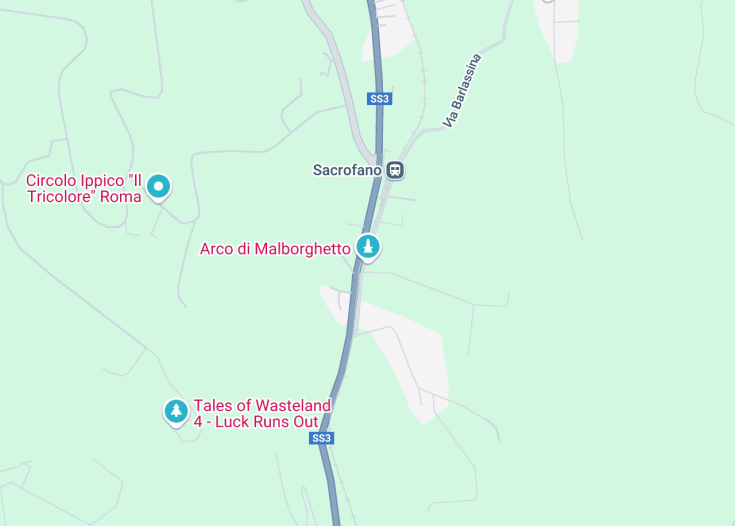The Arco di Malborghetto, situated just nineteen kilometers from Rome along the ancient Via Flaminia, is a remarkable remnant of Roman architecture. Dating back to the early 4th century, this impressive tetrapylon, though restructured over the centuries, offers insight into the engineering prowess and historical significance of the Roman Empire.
Visitors to the Arco di Malborghetto should consider exploring the surrounding area, where remnants of ancient roadways provide context to this historic structure. Engaging a local guide can enhance your experience by unveiling the rich narratives tied to the site.
When planning your visit to the Arco di Malborghetto, aim for a weekday when crowds are lighter, allowing for a more intimate experience with the monument. Be sure to wear comfortable shoes as you explore the ruins and verdant landscapes nearby.
Explore the Architectural Marvel of Arco di Malborghetto in Rome, Italy
The Arco di Malborghetto, an imposing tetrapylon structure, exhibits a remarkable fusion of Roman architectural influences and medieval adaptations. Originally erected in the early 4th century, this monumental gateway is characterized by its rectangular design, measuring approximately 14.86 m by 11.87 m, and is believed to have reached a height of around 18 m. Supported by four massive arches, the structure served as a crucial juncture for the Via Flaminia and the Via Veientana. Although the original marble cladding has eroded over time, remnants of brickwork and evidence of metal anchor points can still be observed on the exterior walls, signifying the grandeur of its initial design. The interior layout, divided by walls into three communicating archways, further highlights the architectural sophistication of the era. This impressive edifice transitioned into a medieval church in the 11th century, showcasing the adaptability of historic structures throughout time.
History
4th Century – Roman Era
The Arco di Malborghetto was constructed in the early years of the 4th century AD. Originally, it was a tetrapylon designed to commemorate significant road intersections. Featuring four arches that connected travelers along key Roman routes, it also symbolized the power of Emperor Constantine I, marking an essential route for commerce and military movements.
11th Century – Medieval Transformation
During the 11th century, a major transformation occurred when the structure was converted into a church with a cross-shaped layout. The arches were closed with solid walls, and an apse was constructed on the eastern side, indicating a significant shift in function from a civic monument to a place of worship. This adaptation reflects the medieval period’s reverence for repurposing ancient structures.
16th Century – Renovation and Decline
In the 16th century, the site fell into disrepair until a Milanese herb merchant, Costantino Pietrasanta, leased it. He undertook extensive renovations, which altered the appearance and functionality of the site yet again. Over the centuries, it transformed into various roles, including an inn and post station, symbolizing the ebb and flow of urban development in Rome.
Activities and Features at Arco di Malborghetto
The Arco di Malborghetto offers visitors an engaging exploration of its historical and architectural significance. Walking through the area, one can observe remnants of ancient roads and urban layouts that reveal insights into ancient Roman engineering. Guided tours are available, providing in-depth interpretations of its various phases and transformations. Moreover, the site often serves as a backdrop for cultural events and exhibitions organized by the Superintendency of Cultural Heritage, fostering a connection between history and contemporary culture.
Remarkable Insights into the Structure’s Purpose
What stands out is the Arco’s intriguing original purpose as a monumental entry point to the intersecting roads, specifically during a pivotal moment in Roman history. It is believed to have served as a military assembly area, where troops gathered prior to significant battles, including the legendary confrontation between Constantine and Maxentius. This strategic location not only emphasizes its importance in ancient military logistics but also adds a layer of legendary narrative to its historical context.
General informations
Location
The Arco di Malborghetto is situated in the picturesque Roman countryside, specifically on the nineteenth kilometer of the ancient Via Flaminia. It is located about 19 kilometers north of the city center of Rome, near some notable landmarks that make it easily accessible for visitors.
Address:
Via Flaminia, Km. 19,4, 00036 Roma RM, ItalyVisiting Information
The Arco di Malborghetto is open to the public, allowing visitors to explore this historic site without strict closing hours. It is advisable to visit during the early morning or late afternoon to experience the site with fewer crowds and to enjoy the serene surroundings.
How to reach Arco di Malborghetto
Car
The Arco di Malborghetto is easily reachable by car. Parking is available in the vicinity for a small fee, making it convenient for visitors traveling from different areas.
| Route | Distance | Travel time |
|---|---|---|
| From Rome City Center | 19 km | 30 minutes |
| From Fiumicino Airport | 40 km | 45 minutes |
| From Ciampino Airport | 30 km | 35 minutes |
Public Transport
The Arco di Malborghetto can also be reached by public transport. Visitors can take a train from the central station to the nearby stations and then use local bus services to reach the site.
| Route | Distance | Travel time |
|---|---|---|
| From Termini Station | 19 km | 45 minutes (train + bus) |
| From Tiburtina Station | 22 km | 50 minutes (train + bus) |
Accessibility and Limitations
The Arco di Malborghetto is relatively accessible, though visitors should be aware of some limitations in terms of mobility within the historic structure.
Accessibility
Limitations
- Some areas may be closed for preservation efforts.
- Guided tours may need to be arranged in advance.
Notes to visitors
- Wear comfortable shoes due to uneven paths.
- Bring water and snacks, as facilities on site are limited.
Common questions
What is the architectural style of the Arco di Malborghetto?
The Arco di Malborghetto showcases a distinctive architectural style that reflects its Roman origins. Initially constructed as a tetrapilo, its design is characterized by a rectangular plan that measures approximately 14.86 meters by 11.87 meters. The structure features four arches, similar in style to the Arco di Giano at the Velabro.
Despite extensive renovations over the centuries, the underlying Roman architecture remains visible. The original design likely included a marble façade, now lost, with travertine bases supporting the arches. These features contribute to the impressive height of the structure, which is estimated to have been around 18 meters. The significant dimensions and classical elements indicate its importance as a monument in ancient Rome, making the Arco di Malborghetto an intriguing example of Roman engineering and aesthetics.
Are there any notable artworks or decorations at the Arco di Malborghetto?
Currently, the Arco di Malborghetto does not feature notable artworks or decorations visible to the public, primarily due to its state of preservation and changes over time. Originally, the tetrapilo would have been adorned with marble cladding and possibly sculptural elements, reflecting the artistic styles of the Roman Empire.
However, much of this ornamentation has been lost or repurposed throughout centuries. The historical significance of the site lies not in surviving artworks but in its architectural structure and the archaeological insights it offers about Roman engineering and urban planning. Visitors may find traces of ancient materials and the remnants of construction techniques used in its original assembly, which provide a unique glimpse into Rome’s architectural past.
What can visitors expect to see surrounding the Arco di Malborghetto?
Visitors to the Arco di Malborghetto can expect to find a rich archaeological landscape surrounding this historical monument. The area encompasses remnants of the ancient Via Flaminia and the Via Veientana, both crucial routes in Roman times. Unearthed sections of the original roadways, complete with basalt pavements, can still be seen, offering a glimpse into the transportation infrastructure of ancient Rome.
Additionally, the surrounding landscape features various archaeological remains and the vegetation typical of the Italian countryside, enhancing the serene charm of the location. The site also serves as a museum and a branch of the Sovraintendenza dei Beni Culturali, providing educational resources for visitors interested in history and archaeology. These elements combined create a fascinating environment where visitors can explore the legacy of Rome beyond the confines of its urban centers.
Is the Arco di Malborghetto easily accessible for tourists?
The Arco di Malborghetto, while located outside the heart of Rome, is accessible for tourists who are eager to explore ancient Roman sites. Although it is situated approximately 19 kilometers from the city’s center, visitors can reach it by utilizing public transportation options such as buses or by driving. The surrounding road infrastructure connects it to popular routes leading to Rome.
Once at the site, the Arco di Malborghetto is open to visitors, allowing them to appreciate the impressive structure up close. The area is well-marked and typically offers information signs in both Italian and English, making the historical context accessible. While it may not be as frequented as other attractions in Rome, those who make the journey will enjoy a quieter, more contemplative experience with the rich history that the monument embodies.
What nearby attractions should visitors consider when visiting the Arco di Malborghetto?
Visitors to the Arco di Malborghetto should consider exploring several nearby attractions that showcase the rich historical and cultural heritage of the region. One notable site is the ancient archaeological remains located along the Via Flaminia, which provide a fascinating glimpse into Roman infrastructure and urban planning.
Another destination worth visiting is the ancient settlement of Veii, located a short drive from Malborghetto. This site features extensive ruins of the Etruscan city that rivaled Rome and offers a deeper understanding of the area’s pre-Roman history. Additionally, the beautiful Roman countryside surrounding the monument presents opportunities for walking and enjoying the scenic landscapes.
Lastly, the nearby towns and local eateries provide an authentic taste of Italian culture, where visitors can savor traditional cuisine while soaking in the historical ambiance of the region. These attractions create a well-rounded experience for tourists exploring the Arco di Malborghetto and its surroundings.

Is the Arco di Malborghetto in Rome worth visiting?
The Arco di Malborghetto is a fascinating historical site that offers a glimpse into ancient Roman architecture and history. As a tetrapilo from the IV century, it holds significant cultural value. Located just north of Rome along the busy Via Flaminia, visiting this monument allows tourists to appreciate its unique architecture, which stands as a testament to its transformation over the centuries—from a Roman structure to a medieval church, and now a preserved site of interest.
Although it may not be as well-known as other iconic Roman sites, the arco’s history and architectural features make it worth the detour. Visitors can explore its robust remains and enjoy the serene countryside surrounding the area, offering a peaceful contrast to the bustling city.









